Whether discolored patches in the grass or small, brown mushrooms in the lawn - mushrooms in the garden are not uncommon and can appear in very different ways.
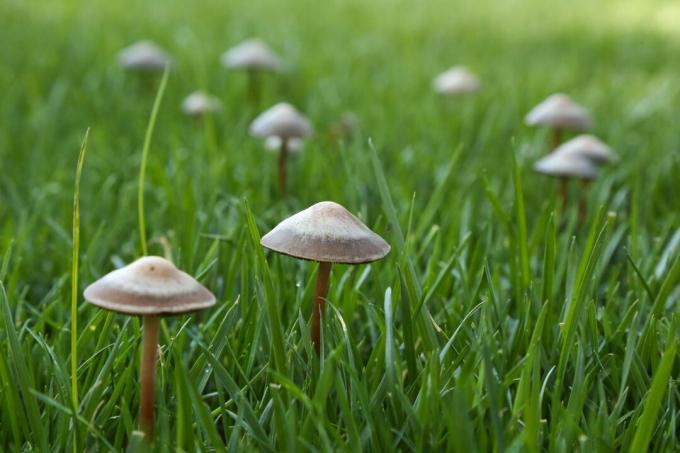
When you think of mushrooms, you usually think of classic cap mushrooms. Mushrooms mainly grow underground. What we see in the lawn are just the fruiting bodies, which sometimes bulge to the surface. The networks under the ground are important because, like microorganisms, they ensure fertile soil. Many fungi live in symbioses with plants, with both fungi and plants benefiting from an exchange of substances. However, there are fungi that cause damage in the garden as pathogens. Some are not symbiotic, but parasitic: that is, they benefit from the plant, but not vice versa. For example, a lawn fungus can be edible and desirable, or it can cause trouble.
contents
- Why do mushrooms grow in the lawn?
-
What mushrooms grow in the lawn?
- Common Giant Parakeet (Macrolepiota procera)
- Carnation swindler (Marasmius oreades)
- Crested Inkling (Coprinus comatus)
- Field funnel (Clitocybe quisquiliarum)
- Witch rings in the lawn
- Snow mold in the lawn
- red point
- stem rot
- More mushrooms in the lawn
- Control and remove fungi in the lawn
Why do mushrooms grow in the lawn?
There are many different reasons why fungi appear on the lawn. In general it can be said that fungal spores are always present in the air and always germinate and colonize a location when the conditions suit them. Different fungi specialize in different conditions. Fungi in the lawn mainly appear when it is damp and shady. For example, mushrooms thrive on a heavily mossy lawn. These are conditions that are less palatable to the lawn, often weakening by the time fungi appear. Lawn fungus, which lives parasitically on the lawn and damages it, is therefore rarely the cause of lawn problems, but rather a weak parasite. But not every fungus in the lawn also parasitizes it - in fact, almost all cap fungi are completely harmless to the lawn. However, they are an indicator that conditions prevail that are not conducive to the lawn.
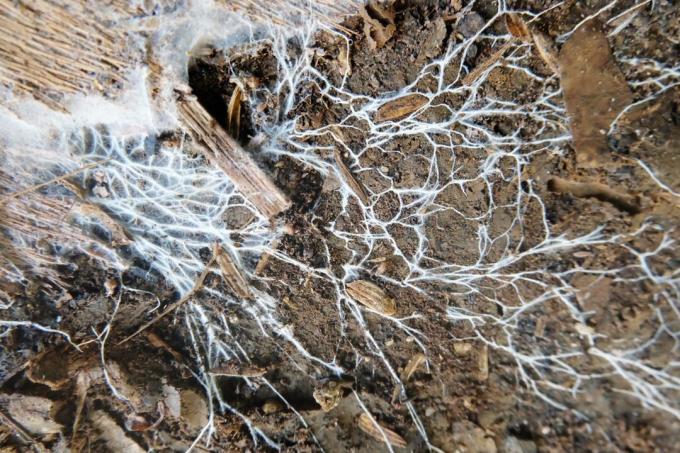
Are mushrooms in the lawn a good sign? Mushrooms themselves are very exciting creatures and nothing bad in themselves. However, since fungi need very different site conditions than lawn grasses, their presence indicates conditions that are rather unfavorable for the lawn. The lawn is weakened by the poor growth conditions. Lawn diseases also appear as weakness parasites: a healthy lawn rarely falls victim to them. The most important prevention and control is always good lawn care.
At a glance: Causes of fungi in the lawn
- Spore distribution through the air
- Existing fungal hyphae in the garden soil
- Moisture, including waterlogging
- the shade
- Appropriate site conditions due to improper soil preparation or lawn maintenance
- Deadwood in the garden soil
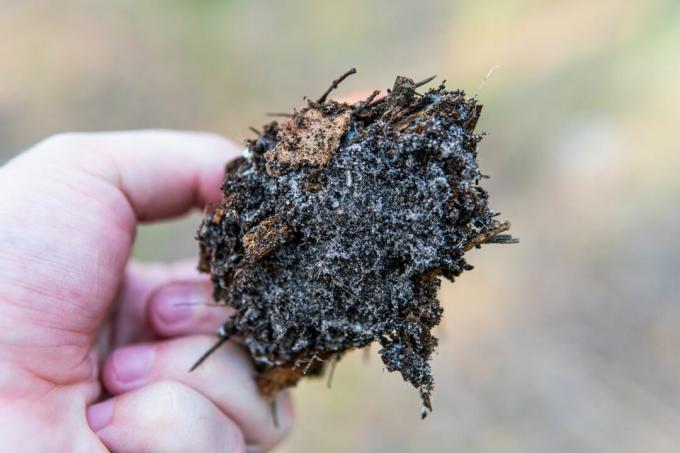
What mushrooms grow in the lawn?
First of all, a distinction must be made between cap and pillar mushrooms, whose fruiting bodies can be seen above ground, and those mushrooms that only occur underground. Strictly speaking, some fungi are now classified as algae, but are known as fungi. Saprobiotic fungi, which are not dependent on specific trees but on dead, organic material, can occur freely in the lawn. Basically, hardly any edible mushrooms grow in the lawn. Most are inedible, some even poisonous. Since it is so difficult to identify, to be on the safe side, you should not eat wild mushrooms from the garden. There are, however, a few edible cap mushrooms in the lawn that are sometimes found in the garden. These can turn out to be undesirable, for example through the formation of witch rings.
Tip: Witch rings are ring-shaped appearances in the lawn caused by fungi. The rings can consist of the fruiting bodies of the mushrooms, or just dead or particularly vigorous grass. They are created by the underground fungal network.
Common Giant Parakeet (Macrolepiota procera)
This edible mushroom is also called parasol. It is one of the lamellar fungi that can be seen by looking under the white and brown patterned umbrella. A characteristic of the common parasol is the ring on the handle, which can be moved. The parasol can also form witch rings and be mistaken for poisonous doubles.
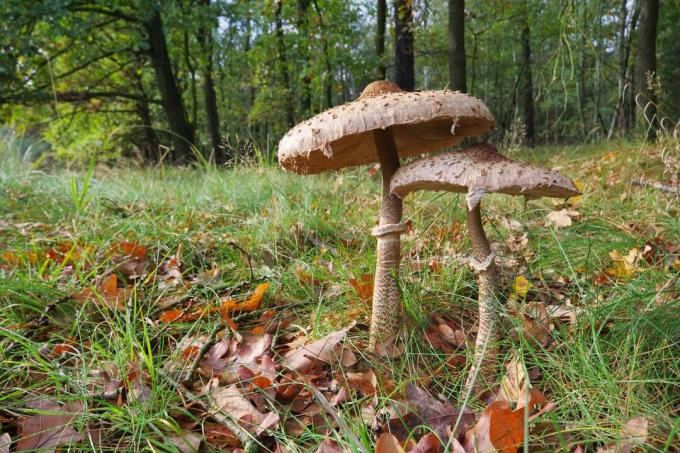
Carnation swindler (Marasmius oreades)
This edible mushroom also has lamellae that sit under a wide, flat, brownish cap. However, it can also form witch rings and can easily be confused with other, poisonous types of mushrooms.
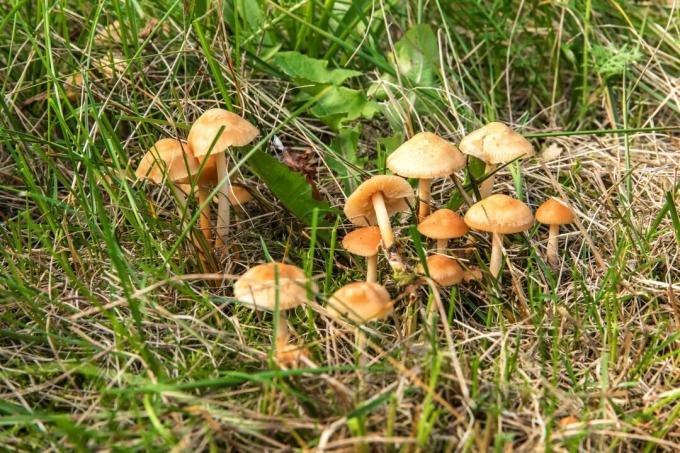
Crested Inkling (Coprinus comatus)
The Schopf-Tintling is a popular edible mushroom among mushroom connoisseurs, which usually does not form witch rings in the lawn. However, the whitish, long, downward-curved peak cannot be used as a clear identification feature.

Field funnel (Clitocybe quisquiliarum)
This garden fungus is found in meadows and lawns and belongs to the lamellar fungi. He has a flat, later funnel-shaped, whitish to yellowish cap. It is poisonous and must not be consumed. The Field Funnelling can also form Witch Rings.
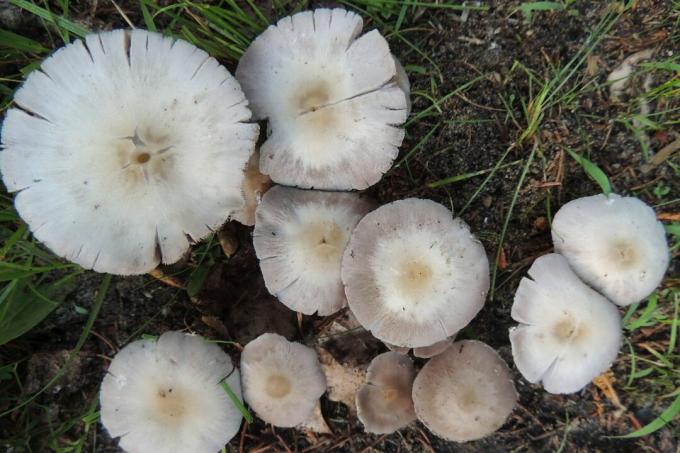
Witch rings in the lawn
A very well-known and unpopular phenomenon of fungi in the lawn are witch rings. The fruiting bodies of the mushrooms appear ring-shaped. Witch rings can be caused by many different types of fungi. They can recur every year and increase in size as they do so. Mushroom fruiting bodies do not always have to be visible. The origin here is also in the underground mushroom mycelium, i.e. the hyphal network. This can also become visible when the lawn dries up and dies in a ring. There are three types of witch rings:

Type 1: Usually no fungal fruiting bodies can be seen here, just a light ring of chlorotic yellow grasses enclosed by two dark green rings. If you dig a little at this point, you can see the white mycelium in the ground.
Type 2: In this type, if the conditions are right, the fruiting bodies of the mushrooms can appear. Otherwise, only a single, dark green ring can be seen, on which the grasses are growing more intensively.
Type 3: This is the most conspicuous type, as this is where the fruiting bodies can be seen. They are often arranged in a ring, but can also take on other shapes. It can happen that grasses in the inner area of the ring are chlorotic yellow or die off.
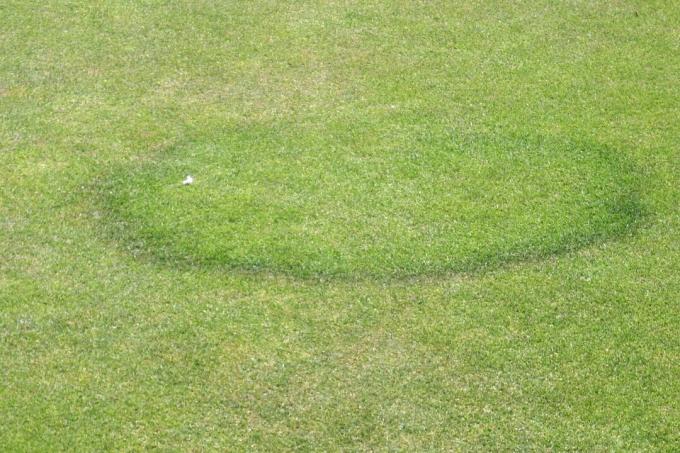
But witch rings in the lawn are no reason to panic. You can take action and treat the lawn in such a way that further occurrences can be prevented. Above all, action should be taken against type 1, as this severely damages the lawn. In order to take action against the witch ring, conditions should first be created that are unsuitable for mushrooms but conducive to the lawn. The fruit bodies, if present, are separated with a knife and discarded so that the spores do not spread further. The lawn should be loosened up with a digging fork or otherwise aerated be, which ensures good aeration of the soil. In addition, one should ground sandso that it becomes more permeable. Our sand, for example, is suitable for better aeration of the soil Plantura lawn sand terrific. It can be applied by hand or with a spreader and, thanks to its fine grain size, trickles deep into the previously opened soil. After tillage, new grass should be sown in affected areas. When mowing the lawn in the future, the clippings should be removed to avoid matting the surface of the lawn.
Snow mold in the lawn
The so-called snow mold is also caused by fungi. It shows up in light, yellowish spots on the lawn. When the humidity is high, you can see the greyish mycelium. If the soil is heavily compacted, over-fertilized and the grass weakened, the lawn is particularly vulnerable. A high, i.e. alkaline, pH value also promotes snow mold. Autumn or spring, when rain and low temperatures are more common, is snow mold season. It mainly occurs at temperatures between 0 and 10 °C. If it is too cold or too warm, the spread is prevented. Since the ideal conditions for the disease to occur under snow cover in spring, it has been given the name snow mold. The fungal pathogens are mostly Microdochium nivale or Monographella nivalis.
Control is not absolutely necessary as the disease itself disappears with rising temperatures.
- Snow mold can be prevented by ensuring good permeability and aeration by scarifying and sanding the lawn with sand and removing clippings and leaves from the lawn.
- With a potassium-rich autumn lawn fertilizer, such as ours Plantura Organic Autumn Lawn Fertilizer, the grasses are strengthened again before winter and are thus better armed against winter fungal infestation. Our fertilizer also promotes active soil life, which is just as important for a healthy lawn and soil.
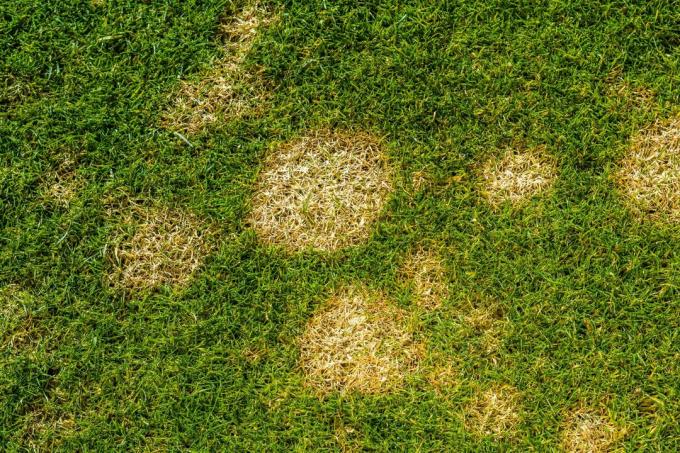
red point
Also the red thread caused by the fungus Laetisaria fuciformis is caused, initially manifests itself in light, yellowish or reddish spots on the lawn. Lawns that are weakened or stressed due to weather conditions are preferentially attacked. The disease can occur all year round, but is less likely in winter and summer. Temperatures of 5 to 30 °C are necessary for an eruption. Especially when it is damp outside, you can see the fungus mycelium on the affected grasses, which looks like a pink piece of cotton wool. In addition, reddish or pink outgrowths that look like antlers form on the grasses.
Since the red point in the lawn occurs more often in warm, humid weather and on weakened lawns, the right care is crucial:
- The lawn should not be watered too frequently or too much so that the moisture does not remain on the grasses.
- In addition, a sufficient supply of nitrogen to the grasses, especially in spring, is important.
- In order to prevent matting and moss formation, it should be regularly fertilized, mowed, the clippings removed and scarified every few years.
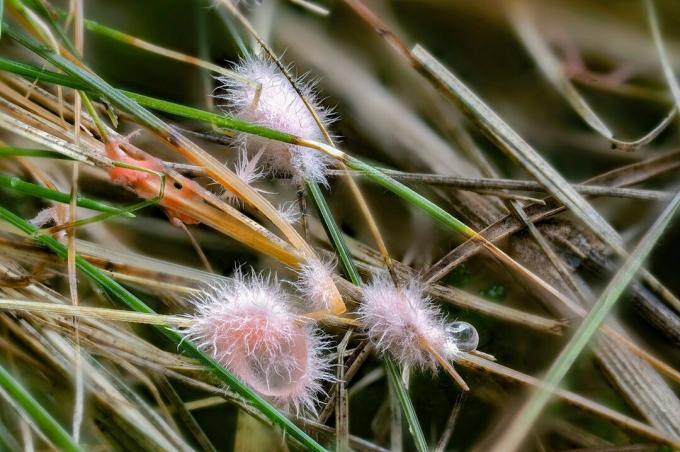
stem rot
Young grasses in the seedling stage are particularly affected by stem rot. The causative agents of stem rot are fungi of the genus pythium. Warm, humid weather favors the outbreak of the disease. It can be recognized by the rotting shoot base of the seedlings and by the black, dying roots. But even more developed lawns can be infested and develop into brown, slimy areas. The brown roots of the grass are completely decomposed over time. Gradually, the entire lawn can be affected.
- As with other fungal diseases, good aeration of the soil is an effective way to prevent infestation. Aerating and sanding works wonders for stem rot problems. Matted lawns should be scarified if necessary.
- It is also advisable to water in the morning hours so that the water can evaporate over the course of the day and does not remain as a damp film on the grass.

More mushrooms in the lawn
There are other lawn fungi that are not particularly common in gardens, but occasionally grow on meadows or lawns:
- giant puffball (Calvatia gigantea)
- White aniseed mushroom (Agaricus arvensis)
- Common Saffron Parakeet (Chlorophyllum rhacodes)
- may mushroom (Calocybe gambosa)
- giant boletus (Entoloma sinuatum)
Control and remove fungi in the lawn
Do you have mushrooms in your lawn and are wondering what to do? Fighting fungi in the lawn is fundamentally difficult. Rather, the focus should be on preventive measures so that the fungi do not appear in the first place. Good soil preparation before the new lawn is laid is the be-all and end-all here. Regular grooming is also helpful in preventing fungi. The following measures are effective in preventing fungal infestation in the lawn and at the same time help to keep the lawn healthy:
- Ensure aeration: in the root area by raking, deep down by aerating and sanding the soil. Sand also makes the soil more permeable.
- Scarify regularly to remove thatch and moss and aerate the turf.
- Remove leaves from the ground.
- Water in the morning so that no moisture remains on the surface for a long time.
- Appropriate fertilization: Sufficient, but not too rich in nitrogen, especially in autumn.
- Ensure the right soil pH: Read with us how you can Lime the lawn properly.
- Mow occasionally with a basket on heavy soil to avoid accumulation of organic material in the turf and thus formation of thatch.
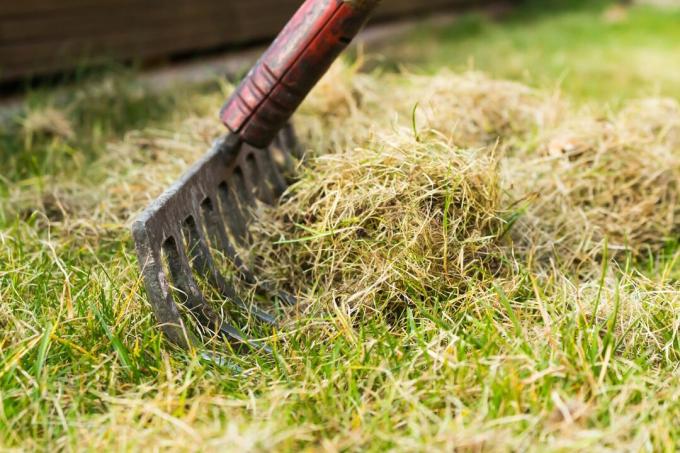
To remove the mushrooms in the lawn, the fruiting bodies can be separated with a knife and disposed of. However, they continue to live underground. The garden soil should therefore be made unattractive to harmful fungi. What is particularly important is a pH value that suits the type of soil and thus also ensures a healthy lawn. If the soil pH is too low or too high, action should be taken. If the pH value is too low, i.e. too acidic, it is advisable to lime the lawn so that the pH value increases. For example, our Plantura Organic Lawn & Garden Lime which ensures fertility and, through the lime, helps to bring acidic soil back into a suitable area for the lawn. Our lime is safe for pets and garden animals.
Do fungi in the lawn go away on their own? If you only look at the fruiting bodies of the mushrooms, then mushrooms in the lawn disappear by themselves. However, the underground mycelium remains, so the fruiting bodies will appear again. To avoid this, the lawn must be properly cared for.
Since mushrooms can be found underground everywhere in the soil and the spores adhere to organic material, a mushroom can sometimes sprout from purchased potting soil and spread in the raised bed. More information about Mushrooms in the raised bed is available in our special article.



